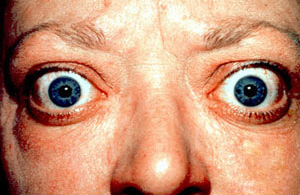
Thyroid eye disease is frequently observed in patients with Graves’ disease, but its prevalence in these patients has not been extensively investigated. A new meta-analysis has revealed that about 40% of those with Graves’ disease develop thyroid eye disease.
As part of their research, scientists reviewed 57 articles that covered nearly 27,000 patients. They looked not only at the overall prevalence of thyroid eye disease, but its specific prevalence in different geographical regions as well as characteristics of the patients with the disease, including the symptoms they experienced.
The Oceania part of the globe showed the highest prevalence of thyroid disease (58%), though these data were based on only one study and so need to be corroborated by future studies. Other regions showed prevalence rates between 27% and 48%. After Oceania, the region showing the highest prevalence of thyroid eye disease was the Middle East (48%), followed by Asia (44%), Europe (38%), Southeast Asia (35%), and finally, North America (27%).
Though people of Asian descent displayed a higher prevalence of thyroid eye disease than did their White counterparts, the difference was not deemed statistically significant, and the researchers suggested that more research is needed to determine if and why Asians may be at higher risk for the disease.
According to the analysis, the most common clinical features of thyroid eye disease were lid retraction and proptosis, which both occurred at rates of 57%. Diplopia and ocular hypertension were also commonly observed, manifesting at rates of 36% and 13%, respectively.
Based on their findings, the researchers suggested that there should be clearer guidelines for physicians in diagnosing and reporting thyroid eye disease so that the burden of the disease can be better understood and addressed.
Reference
Chin, Y.H. et al. (2020). Prevalence of thyroid eye disease in Graves’ disease: A meta-analysis and systematic review. Clinical Endocrinology. doi.org/10.1111/cen.14296
